
Small Space, Big Blooms: 10 Creative Ideas for a Container Garden
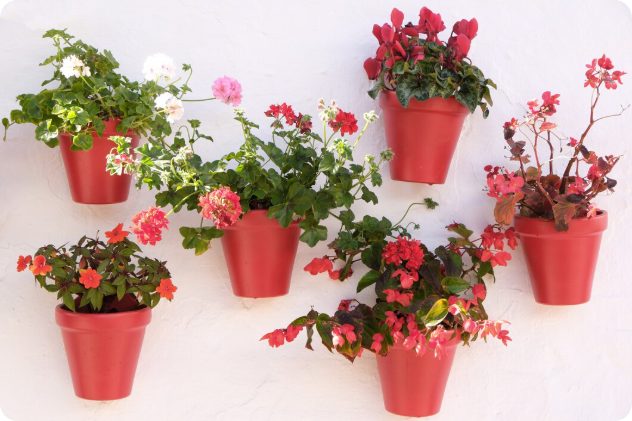
A container garden brings nature to your doorstep, balcony, or patio with style and simplicity.
Even without a large yard, it’s easy to grow herbs, flowers, or vegetables in pots, baskets, and upcycled containers.
This flexible gardening method works well for beginners and experienced green thumbs alike.
Containers allow better control over soil, sunlight, and placement. Move them around to catch the sun, protect them from wind, or refresh the layout with the seasons.
From terracotta pots to painted cans, every container tells a story and adds character to the space.
Herbs on a kitchen ledge, tomatoes on a sunny balcony, or bright flowers in a hanging basket—all these ideas bring life to your surroundings.
Different heights, textures, and colors add depth and beauty even in the smallest corners.
This list of container garden ideas shows how to bring charm and freshness into any space.
Explore combinations of edible plants, decorative blooms, and smart container choices that match your lifestyle.
Whether the goal is beauty, function, or both, these ideas will inspire a fresh approach to growing green in small spaces.
Start with one pot, and soon you’ll have a garden full of life.
10 Ideas for a Container Garden
A container garden is a smart way to bring greenery into small spaces. You don’t need a large backyard. Just a few pots, some soil, and your favorite plants.
Container gardening is perfect for patios, balconies, porches, and even indoor corners. It also lets you move plants easily, so they get the light and shade they need.
Whether you grow flowers, herbs, or vegetables, containers offer control and creativity. Mix colors, play with textures, and reuse old items as planters.
Let’s explore 10 unique and practical ideas to inspire your next container garden.
1. Herb Garden in a Wooden Crate

Herbs grow well in containers, and a wooden crate gives them a rustic look. It fits nicely on a porch, balcony, or windowsill.
You can also carry it from one spot to another to catch the sun.
Use organic potting mix and group herbs by type. For example, plant basil, oregano, and thyme together. These herbs like the same amount of sun and water.
Water when the top inch of soil feels dry. Keep the crate in a sunny spot for best results.
Add a layer of gravel at the bottom to improve drainage. Line the crate with garden fabric to prevent soil from falling out.
Small chalkboard labels or wooden tags help keep track of each herb.
Extra Tip: Start with young herb plants from the nursery. They grow faster than seeds and are easier to manage.
2. Hanging Buckets on a Fence
Hanging buckets save ground space and turn plain fences into living walls. This idea adds height and color to your outdoor space.
Choose buckets with handles, so they’re easy to hang with hooks. Drill small holes in the bottom of each bucket to allow extra water to drain out.
Fill the buckets with lightweight potting soil. Use flowers like geraniums, marigolds, or trailing vines such as ivy.
These plants look great and spill over the sides for a soft, full look.
Hang buckets in patterns—straight lines, circles, or zig-zags—to add style. Mix colors to make the display cheerful and bright.
Paint buckets in fun shades for a personal touch.
Extra Tip: Rotate the buckets once a week so each plant gets even light.
3. Vertical Garden with Recycled Bottles
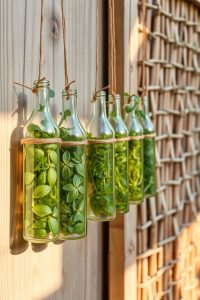
Plastic bottles can become creative and eco-friendly planters. This vertical garden idea fits small balconies or tight corners.
Cut one side of each bottle, poke drainage holes at the bottom, and fill them with soil.
Attach strings or wires to the bottles and hang them from a wooden frame, fence, or wall. Grow herbs like chives, dill, or cilantro.
You can also plant lettuce, baby spinach, or even strawberries.
Paint or decorate the bottles to make the garden colorful. Keep the lighter bottles on top and heavier ones at the bottom for balance.
Water the top row slowly and let the extra water drip to the lower rows.
Extra Tip: Use a drip irrigation system or a spray bottle to water evenly.
4. Wheelbarrow Flower Display
Old wheelbarrows make perfect movable gardens. The shape holds plenty of soil, and the wheel allows you to shift it for better sunlight or to protect plants from storms.
Fill the wheelbarrow with potting mix and compost. Add flowers like pansies, zinnias, or marigolds for a bright and cheerful look.
You can also mix in trailing vines that spill over the sides. Arrange tall plants in the center and short ones around the edges. This adds depth and shape.
Leave a small space between plants so they can grow without crowding each other.
Extra Tip: Drill a few holes in the bottom of the wheelbarrow for drainage. If it’s metal, add rust-resistant paint before planting.
5. Tiered Clay Pot Stand
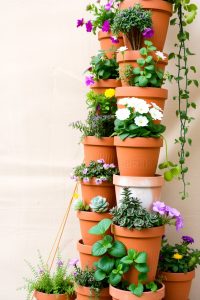
A tiered pot stand saves space and creates an eye-catching display. Stack clay pots in a pyramid style, placing the largest at the bottom.
Fill each pot with different plants. Use the bottom layer for leafy vegetables like lettuce or kale. Use the middle for herbs or marigolds.
Place small succulents or strawberries on the top. Each tier can have its own color or theme.
This setup works well for narrow areas. It also makes watering and care easy. Just turn the stand every few days to keep plant growth even.
Extra Tip: Anchor the pots with a metal rod through the center to prevent tipping.
6. Old Drawers Turned Into Planters
Give new life to old furniture by turning drawers into planters. Pull out the drawers from a broken dresser. Line them with plastic and poke a few holes for drainage.
Use large drawers for vegetables like carrots or radishes. Use smaller drawers for flowers or herbs.
Stack drawers at different angles or place them on wooden blocks for a layered look.
Choose plants that suit the space. Taller ones go in the back. Shorter ones go in front.
Paint the drawers or leave them with a weathered finish for a vintage feel.
Extra Tip: Add wheels under the bottom drawer for easy movement.
7. Succulent Bowl Arrangement
Succulents love shallow bowls. They need less water and soil than most plants. Choose a wide ceramic, clay, or metal bowl. Fill it with cactus mix soil, gravel, and sand.
Arrange small succulents like hens-and-chicks, echeveria, and jade. Leave space between each plant. Add small stones, shells, or driftwood for decoration.
This setup works indoors and outdoors. Place it where there’s bright light. Water lightly once every 10–14 days.
Extra Tip: Avoid overwatering. Succulents rot in soggy soil.
8. Hanging Basket Vegetables
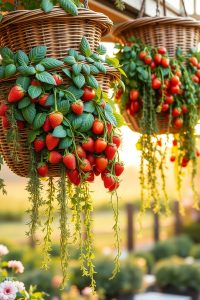
Hanging baskets are great for small fruit and vegetables. Try cherry tomatoes, peppers, strawberries, or bush beans.
Choose baskets that are deep and wide enough for roots to spread.
Use rich, well-draining soil. Add compost to support growth. Water daily in hot weather. Hang the baskets on a balcony rail, porch roof, or tree branch.
Add trailing herbs like thyme or oregano to the edges for a full look. Mix flowers and vegetables for a mix of beauty and use.
Extra Tip: Use coconut fiber liners to keep soil in and give good airflow.
9. Tea Cups for Tiny Plants
Tea cups make adorable mini planters. Use them for small succulents, cacti, or tiny flowering plants. Add pebbles at the bottom, then cactus soil on top.
Arrange the cups on a shelf or tray. Use cups of different colors and patterns. Group 3 to 5 cups for a charming display.
These mini gardens fit in bathrooms, kitchens, or desks. They need very little water and care.
Extra Tip: Don’t overwater. Use a spoon or dropper for better control.
10. Toolbox Garden
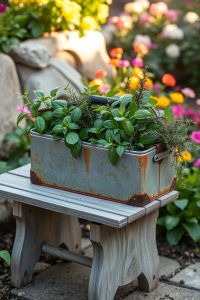
Toolboxes make strong and stylish planters. Wood or metal both work. Clean the toolbox and add holes at the bottom for drainage.
Line it with garden fabric or plastic if needed. Use it for herbs like chives, parsley, or sage. You can also grow salad greens or small flowers.
The handle makes it easy to move around.
Place the toolbox on a table, bench, or stairs. Paint it or leave it natural for a rustic look.
Extra Tip: Store garden tools in a second toolbox nearby for a matching set.
FAQs
What is the best container for gardening?
Any container with good drainage works. Use crates, pots, bowls, or old items like buckets or drawers.
What vegetables grow well in pots?
Tomatoes, lettuce, peppers, beans, and spinach grow well in containers.
How do I stop plants from drying out in pots?
Use mulch on top of the soil. Water regularly. Group pots together to hold moisture longer.
Can I grow plants indoors in containers?
Yes. Choose plants that need less sunlight, like snake plants, pothos, or herbs.
Do I need to fertilize my container garden?
Yes. Use slow-release fertilizer or liquid feed every two weeks during growing season.
How much sunlight do container plants need?
Most need 4–6 hours of sunlight. Some like shade. Always check plant tags.
Can I use garden soil in pots?
No. Garden soil is too heavy. Use potting mix for better drainage and root health.
Why do leaves turn yellow in containers?
Overwatering or lack of nutrients can cause yellow leaves. Check soil moisture and add plant food.
What size pot should I use?
Match the pot to the plant’s root size. Herbs need small pots. Tomatoes need larger ones.
Can I leave containers outside in winter?
Some containers crack in cold. Use frost-resistant pots or move them indoors during winter.
Conclusion
Container gardening brings joy, even in small spaces. It gives you control over soil, water, and sunlight. Each container becomes a small, personal garden.
Whether you use tea cups, wheelbarrows, or crates, the ideas are endless. Try one idea from the list above. Then add another.
Soon, you’ll have a colorful, green space full of life and charm. Container gardens are simple, creative, and perfect for any home.
